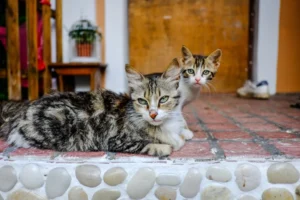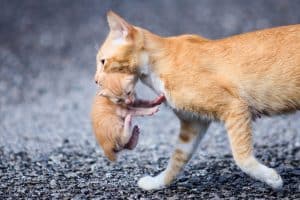Cats are known for their unique behaviors, and one of the most fascinating is their habit of carrying their kittens in their mouth. Have you ever wondered why cats do this? Let’s explore the reasons behind this intriguing behavior.
Answer: Cats carry their kittens in their mouth as a way to protect and move their young to a safe location.
Maternal Instincts
Mother cats have some serious maternal instincts, let me tell you. It’s in their nature to protect and care for their little furballs, and one way they show this is by carrying their kittens in their mouth. Now, don’t worry – they’re not trying to gobble them up for a snack! It’s all about keeping them safe and secure.
When a mother cat carries her kittens in her mouth, she’s actually mimicking what she would do in the wild. In nature, mama cats move their babies from place to place to keep them hidden from predators or to relocate them to a safer spot. So, when Fluffy scoops up her tiny meowers in her jaws, it’s her way of saying, “I gotcha, don’t worry.”
Bonding and Security
Carrying kittens in their mouth isn’t just about transportation; it’s also a way for mama cat to strengthen the bond with her little ones. By picking them up and moving them around, she’s showing them that she’s there to protect them and keep them close. It’s like a security blanket, but in the form of a feline taxi service.
Think about it – when you were a kid, didn’t you feel safer when your parents held your hand or gave you a piggyback ride? Well, that’s kind of what’s going on here. The physical contact between mama cat and her kittens helps them feel secure and loved, building a strong emotional connection that lasts a lifetime.
And here’s a fun fact for you: by carrying her kittens in her mouth, mama cat is actually helping them develop their own sense of balance and coordination. It’s like a free ride that also doubles as a kitty gym class! So next time you see a mother cat toting her babies around, just remember – she’s not only a protector but also a personal trainer in the making.
Transportation Methods
Mother cats have several clever ways of moving their kittens around. They might gently grab their little ones by the scruff of the neck in their mouths for short distances within a safe area, ensuring the kittens stay close by and out of harm’s way. When it comes to relocating their precious babies to a new den, mother cats use their mouths to transport them one by one, carefully carrying each kitten to the new location. This kind of transport helps mother cats keep a watchful eye on all their kittens at once, making sure everyone is safe and sound.
Safety Measures
Mother cats are fiercely protective of their kittens and will go to great lengths to keep them safe from predators. By carrying their kittens in their mouths, mother cats can quickly move them to a safer location if they sense danger nearby. This method of transportation allows mother cats to swiftly relocate their babies to a hidden spot, keeping them out of harm’s reach and away from potential threats. It’s a natural instinct for mother cats to use this method to ensure the safety of their precious offspring.
Fun Fact: Mother cats develop a special bond with their kittens through the act of carrying them in their mouths, strengthening the mother-child relationship and fostering a sense of security for the young ones.
Learning to Carry
Mother cats teach their kittens to ride in their mouth as a way to keep them safe and secure while moving them from place to place. This skill is crucial for the survival of the kittens, as it allows the mother cat to transport them without the risk of being separated or attacked by predators. By carrying their kittens in their mouth, mother cats are able to move them to a safe location when danger is present, such as when moving them to a new nest or away from a potential threat.
It is essential for kittens to learn how to ride in their mother’s mouth properly, as this helps them develop trust and coordination. The mother cat gently picks up her kittens by the scruff of their neck, a technique that triggers a reflex causing the kitten to relax and go limp. This ensures that the kitten is comfortable and secure while being carried. As the kittens grow, they will become too heavy for their mother to carry in her mouth, so it is important for them to learn to walk and explore on their own.
Additional Unique Insight:
One interesting fact is that a mother cat’s saliva has a calming effect on her kittens when she carries them in her mouth. This soothing sensation helps the kittens relax and feel safe during transportation.
When to Stop
Mother cats typically stop carrying their kittens once they reach around 4 weeks of age. At this point, the kittens are starting to become more independent and are able to explore their surroundings on their own. The transition from being carried to walking independently is crucial for the development of the kittens, as it helps them build strength and coordination.
As the kittens grow and start venturing out on their own, the mother cat will gradually encourage them to explore their environment and become more self-sufficient. This phase is vital for the kittens to develop their hunting and survival skills, as they learn to navigate the world around them without relying on their mother’s constant guidance.
Remember, each cat and kitten is unique, so the timing of when a mother cat stops carrying her kittens may vary. It’s essential to observe the mother cat and her kittens closely to determine when the kittens are ready to start exploring on their own.
For more information on cat behavior and kitten care, you can check out this helpful resource: Cat Behavior and Kitten Care Guide.
Human Interventions
If you ever witness a mother cat carrying her kittens in her mouth, it’s crucial to understand the importance of allowing nature to run its course. While it may seem instinctive to intervene and try to help, it’s best to let the mother cat handle her kittens on her own. Mother cats have a natural bond with their young, and carrying them in their mouth is a way for them to move their kittens to a safer location or to ensure their comfort and security.
Intervening too much can disrupt this bond and cause unnecessary stress for the mother cat and her kittens. By observing from a distance and providing a safe environment for the family, you can support the natural instincts of the mother cat and allow her to care for her kittens in the way she knows best.
Remember, nature has a way of taking care of itself, and sometimes the best thing we can do is simply observe and offer support when needed.
Fun Facts About Cat Behavior
Kneading: One interesting behavior that many cats exhibit is kneading. This is when a cat rhythmically pushes their paws in and out against a soft surface, almost like kneading dough. This behavior stems from kittenhood when they would knead their mother’s belly to stimulate milk flow.
Purring: While most people associate purring with happiness, cats actually purr for various reasons. They may purr when they’re content, but they also purr when they’re in pain or afraid. It’s believed that the vibrations from purring can promote healing and relaxation.
Hunting: Even in domestic settings, cats retain their natural hunting instincts. This is why they may bring you “gifts” of small animals or toys, as a way to show their hunting prowess and provide for their human family.
Sleeping Habits: Cats are known for their love of sleep, with the average cat sleeping up to 16 hours a day. This is because cats are crepuscular animals, meaning they are most active during dawn and dusk. They conserve energy during the day by napping and save their energy for hunting at night.
Whiskers: Cat whiskers are not just for show; they are highly sensitive tactile hairs that help cats navigate their environment. Whiskers can detect changes in air currents, assess the size of openings, and even pick up on vibrations.
Next time you observe your feline friend’s quirky behaviors, you’ll have some fun facts to help you better understand why they do what they do!
Alex, a passionate animal lover, has experience in training and understanding animal behavior. As a proud pet parent to two dogs and three cats, he founded AnimalReport.net to share insights from animal experts and expand his knowledge of the animal kingdom.









